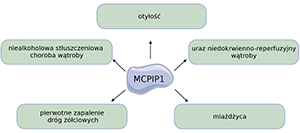Role of MCPIP1 protein in lipid metabolism, liver homeostasis and non-alcoholic fatty liver disease
DOI:
https://doi.org/10.18388/pb.2021_446Abstract
Non-alcoholic fatty liver disease (NAFLD) is characterized by excessive accumulation of lipids in hepatocytes. Among NAFLD patients, in 25% of them this disease progress to nonalcoholic steatohepatitis, which is characterized additionally by the development of inflammation and fibrosis of liver. Currently, it is estimated that 24% of the world’s population suffers from NAFLD. MCPIP1 protein is an RNase described as a negative regulator of inflammation. Also, MCPIP1 plays a role in lipid metabolism because it inhibits the process of adipogenesis and mice with a deletion of Zc3h12a gene are characterized by dyslipidemia and reduced body fat content. In the case of ischemia-reperfusion injury in liver, MCPIP1 is protective against the inflammation and damage of this organ. Lipid accumulation by hepatocytes is associated with a decrease of Mcpip1 level. In addition, MCPIP1 may influence the PPARγ-mediated lipogenesis process. Presence of Mcpip1 in both myeloid leukocytes and liver epithelial cells is crucial for the maintenance of liver homeostasis.

Published
Issue
Section
License
Copyright (c) 2022 Natalia Pydyn, Jerzy Kotlinowski

This work is licensed under a Creative Commons Attribution 4.0 International License.
All journal contents are distributed under the Creative Commons Attribution-ShareAlike 4.0 International (CC BY-SA 4.0) license. Everybody may use the content following terms: Attribution — You must give appropriate credit, provide a link to the license, and indicate if changes were made, ShareAlike — If you remix, transform, or build upon the material, you must distribute your contributions under the same license as the original. There are no additional restrictions — You may not apply legal terms or technological measures that legally restrict others from doing anything the license permits.
Copyright for all published papers © stays with the authors.
Copyright for the journal: © Polish Biochemical Society.



